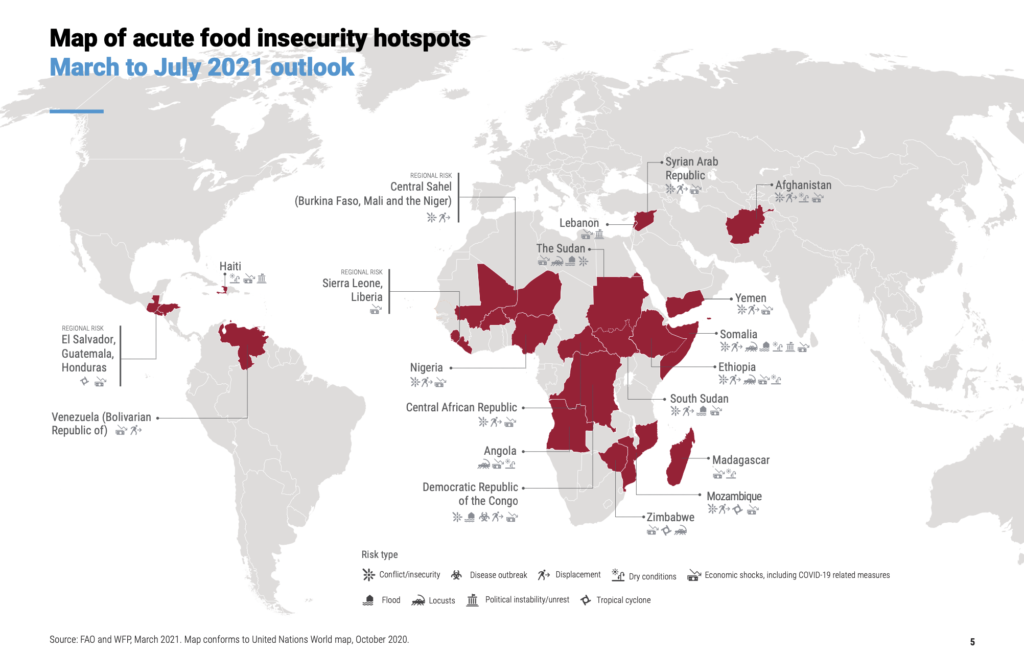Elon Musk recently tweeted;
Replying to @DrEliDavid
“If WFP can describe on this Twitter thread exactly how $6B will solve world hunger, I will sell Tesla stock right now and do it.”
“But it must be open source accounting, so the public sees precisely how the money is spent.”

Which at first seems like Elon Musk shut that conversation down quickly. But, let’s think about this. How would we determine how to solve World Hunger? Here’s some thoughts on what I think would be effective. WFP, the organization the gentlemen that Elon musk is talking to is the World Food Programme. It’s run by members of 36 countries. This article will be based off information from their website, for the most part.
- Define what World Hunger is
I have sat through hours and hours of conversations with people arguing and ultimately, they’re not arguing about the same thing. It’s important to make sure we’re talking about the same thing. So I’ll in this article write a definition of World Hunger. … After a moments thought, I realize I can’t do that. Hunger is a fluid problem. It’s a common conception that there is enough actual food in the world, the problem becomes access to this food. So I’ll try to identify the 3 largest problem areas for food.
According to the Food and Agricultural Organization of the United Nations and the World Food Program there are hotspots in the World that are particularly bad for hunger and famine. I have taken the following quote from their hotspot report from March 2011:
“Yemen, South Sudan and northern Nigeria represent highest alert level for this outlook period due to a combination of factors resulting in a risk of famine. In South Sudan’s Jonglei state and certain areas in Yemen – people are already facing famine-like conditions. These factors include high percentages of the population living in Emergency (IPC Phase 4) food insecurity, heavy constraints to humanitarian access, and a likelihood of worsening food insecurity levels due to conflict, economic blows and climate shocks. Urgent and at-scale targeted humanitarian action is needed to prevent hunger or death in these most at-risk situations and to safeguard the most vulnerable communities. “
After a few minutes of online research it very much seems that this problem has been well defined and that Elon Musk is having the conversation with the right people. Surprise, surprise. It seems obvious, but when headlines float about based off tweets which spark discussions, I assume not much consideration is actually taken.
For the sake of this article and actually defining it. Let’s see if it’s possible for $6 billion to solve the top 3 of the 20 largest problems. The problem being the population not having access to food. To summarize with a bow: World Hunger is the starving people of Yemen, South Sudan and Northern Nigeria.
- What is causing the problem.
You can read the article yourself, but I took the major issue to be conflict. Conflict causes people flee from their homes. Their homes are destroyed, food production is destroyed, supply chains are destroyed. Humanitarian efforts aren’t able to get within the effected areas to deliver food to people. Conflict is the primary issue, because technology is what helps people mitigate other factors on the list, such as natural disasters. Without peace and social stability other problems will compound.
- How big is the problem?
The report has outlined that there are different levels of risk. For the sake of this argument we’re going to look at the IPC/CH Class 4 or 5 illustrated below in Red. That would limit this problem to 9.31 million people based off of Yemen, Sudan and Nigeria. I realize I have cut the numbers down significantly. You could make an argument that all 146.7 million people on this list below (showing the incomplete list), is the number that needs to be solved, but I refer you to the definition in part 1.
We’re going to work with 9.31 million people.
- How can we solve this considering it’s conflict that’s preventing people’s access to food.
There are recommendations for each county. Let’s first look at what they suggest for Nigeria.
| RECOMMENDATIONS • Anticipatory actions Focus on providing conditional cash transfers to conflict-affected communities in the northwest and northeast, using the rapid response registry and the national social register where appropriate, to establish a predictive shock-responsive social protection mechanism. • Provide agricultural inputs and livestock assets to the most vulnerable farming households ahead of the planting season in June. |
| RECOMMENDATIONS Emergency response The HRP calls for USD 354 million for food security and livelihoods, and USD 129 million for the nutrition interventions. • Maintain and expand humanitarian access to conflict-affected areas in the north, allowing for the scale-up of life-saving assistance. • Reinforce supplemental nutrition assistance to women and children in the northeast and the northwest in coordination with government and existing nutrition partners. |
The problem, in my point of view stems from the conflict, not so much the actual access to food.
Let’s look at South Sudan. Sudan seems to have issues that aren’t just related to conflict. They have more serious economic issues that seem to be compounded by conflict. Their weather issues cause either drought or floods and they have poor infrastructure to combat a lot of these problem.
| RECOMMENDATIONS • Anticipatory actions Provide inputs to the most vulnerable farming households ahead of the main agricultural season starting in April, as well as fishing kits to vulnerable rural populations with access to fishing grounds, to increase food availability and income opportunities ahead of the lean season. • Safeguard pastoralist assets through livestock vaccinations and treatments before the start of the rainy season. |
| RECOMMENDATIONS • Emergency response Advocate for and negotiate humanitarian access in conflict-affected areas and unimpeded supply corridors for the movement of essential goods and personnel. • Continue scale-up plan to provide unconditional food and cash transfers and emergency livelihood assistance to local populations, returnees and IDPs, particularly women and children in areas at risk of famine. This includes prepositioning life- saving food ahead of the rainy season in April wherever feasible and appropriate to do so. Leverage life-saving humanitarian programming in hotspots for hunger and violence, including in hard-to-reach locations, across large areas of the country, for more proactive contributions to peace. • Reinforce supplementary nutrition assistance to women and children in areas with high malnutrition rates, in coordination with government and nutrition partners. Build and scale up integrated nutrition programming with WASH and health partners, in order to maximize benefits from nutrition assistance. |
| OTHER KEY ACTIONS • Ensure transformative and sustainable programming by focusing resilience programming not only on ‘pockets of stability’ but also on hotspots of violence and high food insecurity. This will build the resilience of people in some of the most conflict- affected and food-insecure areas. |
Next on our list we have Yemen.
Yemen is rife with conflict and is currently on several humanitarian watch lists. The problem has been persisting for years and that has led to serious famine in the country. Here are the recommendations for Yemen.
| RECOMMENDATIONS • Anticipatory actions Provide key inputs to the most food-insecure farmers, including crop and vegetable seeds and agricultural tools, to allow timely planting for the summer planting season. • Provide irrigation kits including solar water pumps, drip irrigation and water tanks to vulnerable farmers, to overcome the high cost and scarcity of fuel. |
| RECOMMENDATIONS Emergency response The HRP calls for USD 1.7 billion for food security and livelihoods, and USD 443 million for nutrition interventions. • Continue focused advocacy with the Sana’a-based authority to maintain and enhance humanitarian access and ensure consistent assistance provision in Al-Jawf, Amran and Al Hajjah, where there is a high concentration of people in IPC Phase 5. Advocacy should also be directed at lifting the blockade and port restrictions, to enable the movement of much-needed goods and reduce their prices. • Urgent funding to maintain and scale up emergency livelihood and food assistance to millions of people facing acute food insecurity, particularly those in IPC phases 4 and 5. • Urgent expansion of nutrition programmes to maintain prevention and treatment of already malnourished pregnant and lactating women and girls, and children under the age of 5 with severe and moderate acute malnutrition. Particular focus on areas of highest levels of malnutrition and challenging access conditions, including Marib, Al Jawf, Sa’ada, Ad Dali’ and parts of Hajjah, Raymah and Dhamar. • Provide emergency livelihood support, especially to populations in IPC Phase 3, ensuring close collaboration between humanitarian and development programmes, in order to tackle the root causes of food insecurity. |
| OTHER KEY ACTIONS Advocate for fast-tracking the necessary fiscal and monetary policies and explore opportunities to halt and reverse the accelerated depreciation of the Yemeni riyal, thereby easing import constraints and related pressure on food prices. |
- Can you really solve the problems with their methods?
I’m an outside of the box thinker. So just throwing money and food at the problem, is that going to solve the problem? Well yes and no. It will make hungry people not hungry, but it won’t prevent these problems from happening again. My father told me once when the toilet was overflowing and I ran to grab a towel, stop, fix the problem first, then clean it up. These recommendations will not solve the problem. It will not end world hunger.
Can someone intervene? Who should intervene? Do these countries just have to figure their own problems out themselves? If the USA or Canada or the UN came in, would it make a difference? Would they embrace it? My opinion has come to that if these problem are going to be solved, they aren’t being solved by the players involved and there would need to be some sort of third party intervention to allow these places to play nice. That becomes a new form of colonialism and after time can be rejected, so that may not even work. This pessimistic attitude is actually quite depressing. It becomes less about how to get people food and more about how to get world peace and development. $6 billion won’t solve that.
I would love to hear your thoughts on this.

